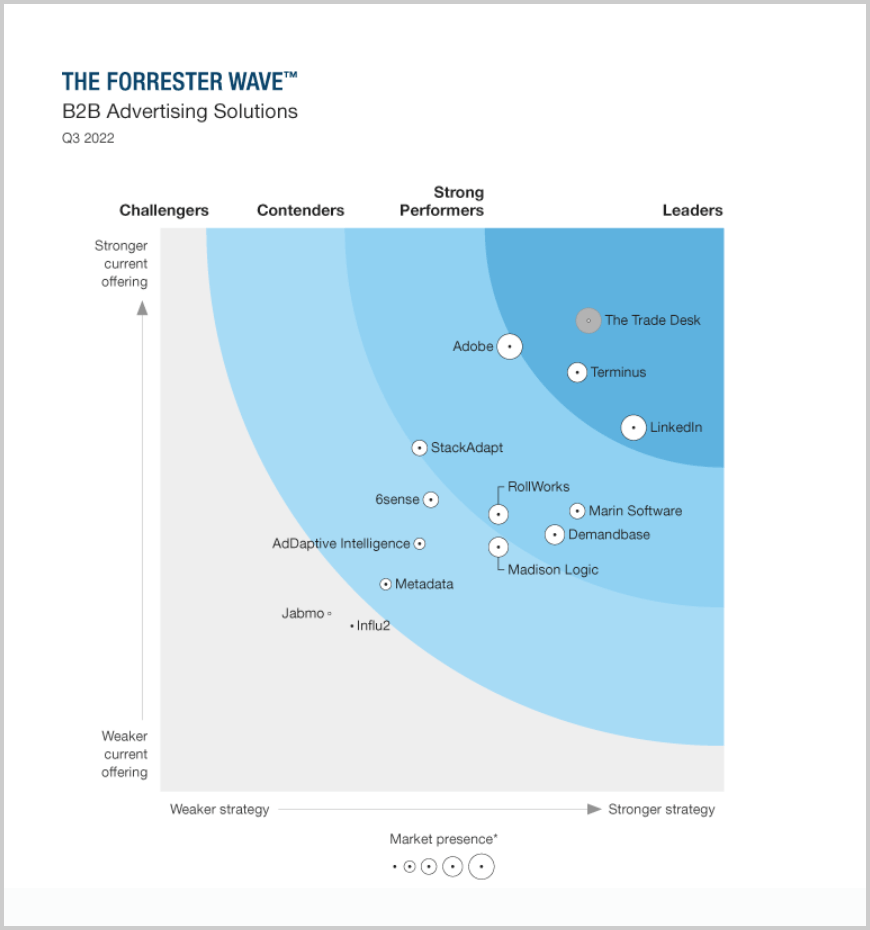2022 CMOs Don’t Want 2010 Solutions: Why The Forrester Wave™ Misses the Mark
Let’s talk about it.
When the Metadata Marketing Team read through the Forrester Wave™: B2B Advertising Solutions report, we were…a little surprised.

Here’s our hot take on where Forrester got it right and where they missed the mark with B2B advertising.
What Forrester got right
Number 1: The state of B2B Marketing
Forrester mentions a bunch of solid points for B2B marketers regarding their tech stack.
First, an obvious one: Business decision-makers spend significant time with digital media. We know this. We’ve known this.
But what have marketers done with that information? Well, it depends. Some marketers are super savvy, and others are just getting into using technology to drive legit campaign results and revenue. So while some folks are taking their first demos, others are realizing they’ve outgrown current solutions and need something new.
Gone are the days marketers have to settle for generic, “all-in-one” solutions or solutions that “only sort of” fit.
With over 9,000 technology options at a B2B marketing team’s fingertips, teams must decide on the right platform(s) to drive revenue and reduce manual, repetitive, and mundane tasks.
Number 2: The state of “Choose Your Own Adventure” in B2B MarTech
Forrester isn’t trying to say you should purchase just one of the 14 platforms it evaluated for the report (thank goodness).
Instead, they recognize that the current B2B advertising landscape means marketers will need to choose multiple tools (as long as there’s no redundancy) to fully match the customer journey and maximize their return on advertising.
The factors Forrester recommends B2B marketers focus on are:
- Business audience reach
- Business context reach
- Cross-channel capabilities
- B2B performance reporting
- Product vision
- Execution roadmap
- Market approach
- Commercial model
- Innovation roadmap
- Delivery model
We’d agree: all of these are important factors for any B2B marketer to consider as they evaluate tools.
We’re just a bit perplexed about the rest.
What Forrester got wrong
Number 1: The focus on display
We get talking about display—it certainly has a place in B2B marketing, but for the focus of an entire report?
That’s where we disagree.
Metadata is a marketing platform marketing to marketers (say that 10x fast), so we hear a ton of feedback on the channels and mediums teams use to drive results. And, display doesn’t come in on anyone’s top 5 list.
Because it shouldn’t.
In a super-scientific study, we asked marketers on LinkedIn for the #1 tool they look for when they’re in the market for a B2B advertising solution.
Surprise: just 1% said they look for display advertising.

The modern marketer doesn’t want a B2B advertising solution that focuses only on display.
It’s 2022. The programmatic landscape is too big for that siloed POV to make even a little bit of sense.
It’s a “not so great” tip of the spear channel: 40% of people in the US use some ad blocker, and marketers can only target entire companies with a slight tilt towards behavior.
That’s why today’s marketers only use display to drive traffic to their website to retarget them on channels that actually convert, like LinkedIn and Facebook (where, incidentally, ads cannot be blocked).
It’s absolutely not the channel or medium of choice.
And guess what platform helps marketers run not only their “tip of the spear” campaigns but also their targeted Facebook, LinkedIn, Google Ads campaigns? This one.
Number 2: Not considering the B2B ecosystem
We were floored by the organizations evaluated for this report: 6sense, AdDaptive Intelligence, Adobe, Demandbase, Influ2, Jabmo, LinkedIn, Madison Logic, Marin Software, Metadata, RollWorks, StackAdapt, Terminus, and The Trade Desk.
Make it make sense.
The issue is the comparison of OG display leaders like The Trade Desk vs. social platforms like LinkedIn vs. ABM solutions like Terminus vs. marketing operating systems like Metadata.
In short:
How the heck does it make sense to narrow all B2B advertising to 14 options and compare them across the same criteria?
This isn’t comparing apples to oranges. It compares Apple to Amazon: both are useful. But each has very different purposes for the end user.
Let’s go back to that poll for a second.
Audience targeting won out overall, and the comments backed it up.
“I think the success of the first three is somewhat dependent on the fourth option,” Jesse Walker, Head of Integrated Marketing at MX, said.
In other words: what Daniel Svonava, co-founder of Superlinked, said: “Targeting > Everything.”
That’s why the comparison points are so perplexing. Why would you rank LinkedIn as having a better audience reach, when Metadata offers marketers (optimized) reach to the same audience?
A bit more here: not only does Metadata activate information from platforms like 6sense and run ads on social networks like LinkedIn, but we also have utilized The Trade Desk to power display capabilities.
There is some good news for B2B marketers evaluating solutions for B2B advertising: this report will help highlight the use case for ABM solutions, social platforms, DSPs, and marketing operating systems.
Like we mentioned, display is not a top 5 key channel for today’s B2B marketers. They need more. And more usually means a mix of the platforms Forrester compared.
In case we weren’t coming in hot enough: this report is not good for evaluating platforms against each other.
Dear Forrester: what gives?
Dear Forrester,
It’s not 2010. Display advertising isn’t the end-all-be-all it once was and ABM isn’t some shiny new toy.
Not one marketer I know would say that if they’re looking for a B2B advertising solution, they’d seek one that focuses primarily on display advertising.
Instead, they’d look for one that helps them optimize their reach, automate their campaigns, and target the right audience.
This means building unique audiences for these ecosystems, making optimizations on the fly to maximize ad spend and powering it all with automation that takes the mundane tasks off the plates of already busy media teams.
This is what the modern B2B marketer demands.
A one-size-fits-all approach to B2B marketing won’t work anymore; marketers can’t throw ads into the abyss and hope they resonate with consumers.
Instead, they need ways to personalize engagement and deliver relevant messaging when it matters most.
It’s clear what CMOs are doing—they’re looking toward the future.
Does that future include display advertising? Of course. It’s still a big part of any holistic B2B marketing campaigns, but it’s just a sliver of what they want—no, what they need.
To run these campaigns, they need a future-facing B2B advertising solution, not one stuck in the past.
So, Forrester, with all that in mind, why the outdated rubric and premium on programmatic display advertising?
We’re just a few months away from 2023 and marketers have long since moved on from display-only campaigns. It’s time to adjust your rubric to reflect that.
Love,
Literally every marketer in the world
Why all this excites us
In many ways, Forrester, you helped prove our point.
We aren’t just a B2B advertising solution. We aren’t a display or ABM platform.
We do a lot more. We’re building a category.
Because B2B Marketers need a lot to drive real, legit results.
We started our journey by building a platform that can generate predictable, tangible demand by automating paid campaigns because there’s nothing more technical, mundane, and repetitive than running paid campaigns.
Today, as Forrester mentions, our strategy is to be “a unique and highly credible option for B2B marketers who are responsible for sourcing high quality leads for salespeople.”
Metadata automates everything from building target audiences, executing 1000s of campaign experiments, and then monitoring, optimizing, and fine-tuning them to what drives pipeline, all while enriching leads and providing a feedback loop of insights.
In 2021, the Metadata platform ran over 70k paid campaign experiments for our 180 customers, at an amazing 1:5 ratio of spend to pipeline. For every $1 our customers spent, they generated $5 in pipeline (yep, read this paragraph again).
And, we’ve got big news coming.
Curious? All we can say is you won’t want to miss DEMAND in October.


